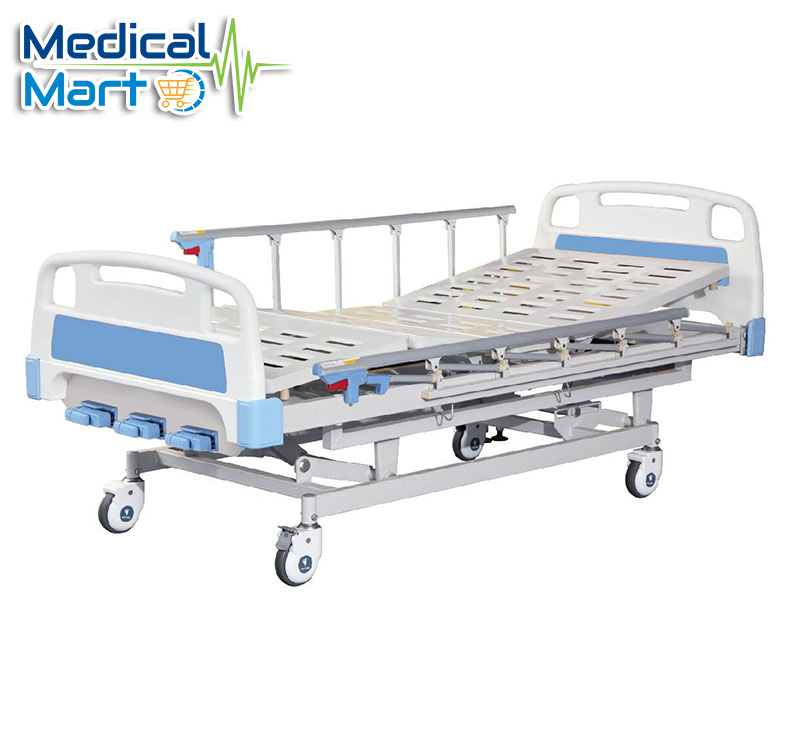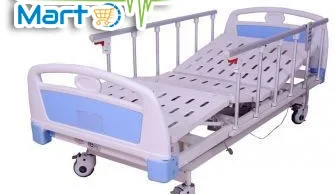Hospital homecare beds, also known as home hospital beds or homecare hospital beds, are specialized medical beds designed for patients who need hospital-level care but wish to receive it in the comfort of their own homes. These beds are an essential component of home healthcare equipment and are particularly useful for individuals with chronic illnesses, disabilities, or those recovering from surgery or medical procedures.
Key features of hospital homecare beds typically include:

- Adjustable Height: Homecare beds are designed with adjustable height settings to facilitate easy entry and exit for both patients and caregivers. This feature also helps with various medical procedures and transfers.
- Adjustable Head and Foot Sections: Most homecare beds come with adjustable head and foot sections, allowing patients to find a comfortable position for sleeping, sitting up, or for medical treatment.
- Side Rails: Some models have removable or collapsible side rails to prevent patients from falling out of bed. These rails can be lowered when not needed.
- Trendelenburg and Reverse Trendelenburg Positions: Advanced homecare beds may offer these positions, which are useful for patients who require specific angles for medical purposes, such as improved circulation or respiratory function.
- Wheels and Locks: Homecare beds are typically equipped with wheels for easy mobility within the home. These wheels can be locked to ensure stability and safety.
- Mattress Options: Various mattress options are available to suit the patient’s comfort and medical needs. These may include pressure-relief mattresses for patients at risk of pressure sores.
- Remote Control: Many modern homecare beds come with remote controls, allowing patients to adjust the bed’s position without assistance.
- Weight Capacity: Hospital homecare beds are designed to accommodate different weight capacities, ensuring the safety and comfort of patients of various sizes.
- Durability and Safety: These beds are constructed with materials that meet medical standards for durability and infection control. They also feature safety mechanisms to prevent accidents or injuries.
- Accessories: Additional accessories like overbed tables, IV poles, and bed trapezes can often be added to homecare beds to enhance their functionality and convenience for both patients and caregivers.
The use of hospital homecare beds can offer several benefits, including improved comfort for patients, reduced caregiver strain, and potentially lower healthcare costs by reducing the need for extended hospital stays. They can be used for a wide range of medical conditions, including post-surgery recovery, long-term illness management, and palliative care.
Before acquiring a hospital homecare bed, it is crucial to consult with a healthcare professional to ensure that the bed meets the specific needs of the patient and is suitable for their home environment. Additionally, insurance coverage and regulations related to the use of these beds may vary by region, so it’s essential to consider these factors when obtaining a homecare bed.
how to choose homecare bed?
Choosing the right homecare bed for your needs or the needs of a loved one involves careful consideration of various factors to ensure comfort, safety, and functionality. Here are steps to help you select an appropriate homecare bed:

- Assess the Patient’s Needs:
• Consult with a healthcare professional or therapist to determine the specific medical requirements of the patient. Consider factors such as mobility, medical conditions, and any special needs. - Determine the Room Size:
• Measure the room where the homecare bed will be placed to ensure that it can accommodate the bed, including space for the patient, caregiver, and any necessary equipment. - Consider the Bed Type:
• Decide whether a manual or electric homecare bed is more suitable. Electric beds offer greater adjustability and convenience but may be more expensive. Manual beds require physical effort to adjust. - Weight Capacity:
• Ensure that the bed’s weight capacity matches the patient’s weight to provide stability and safety. - Mattress Selection:
• Choose a mattress that suits the patient’s needs. Options may include foam mattresses, innerspring mattresses, or pressure-relief mattresses. Consider factors like comfort, pressure sore prevention, and maintenance. - Height Adjustment:
• Check the bed’s height adjustment range to ensure it suits the patient’s needs. This is crucial for ease of entry and exit and for caregiver assistance. - Head and Foot Adjustability:
• Assess whether the bed allows for adjustable head and foot sections. This feature can improve patient comfort and support various medical needs. - Side Rails:
• Determine if side rails are needed for patient safety. Some models have removable or collapsible rails for easy access. - Mobility and Locking:
• Consider the mobility of the bed. Wheels can make it easier to move the bed within the home, but they should also have locking mechanisms to prevent unintentional movement. - Controls:
• If opting for an electric bed, evaluate the control options. Some come with simple hand controls, while others offer more advanced features like programmable positions. - Budget:
• Establish a budget and compare different models within that range. Keep in mind that investing in a high-quality bed can provide long-term comfort and durability. - Accessories:
• Consider any necessary accessories such as overbed tables, IV poles, or bed trapezes. Ensure these accessories are compatible with the chosen bed model. - Safety Features:
• Check for safety features such as emergency stop buttons, anti-entrapment mechanisms, and battery backup in case of power outages. - Warranty and Support:
• Review the warranty offered by the manufacturer and inquire about after-sales support and service options. - Insurance Coverage:
• If applicable, consult with your insurance provider to determine if they cover the cost of a homecare bed and what requirements must be met for coverage. - Reviews and Recommendations:
• Research online reviews and seek recommendations from healthcare professionals or others who have experience with homecare beds. - Test the Bed:
• Whenever possible, visit a showroom or healthcare equipment provider to test the bed and assess its comfort and functionality in person. - Obtain a Prescription:
• In some cases, a prescription from a healthcare provider may be necessary to purchase a homecare bed or have it covered by insurance.
Remember that the choice of a homecare bed should prioritize the patient’s comfort, safety, and medical needs. Consult with healthcare professionals, including physicians and occupational therapists, to make an informed decision that best meets the patient’s requirements.
Remember that the choice of a homecare bed should prioritize the patient’s comfort, safety, and medical needs. Consult with healthcare professionals, including physicians and occupational therapists, to make an informed decision that best meets the patient’s requirements.






